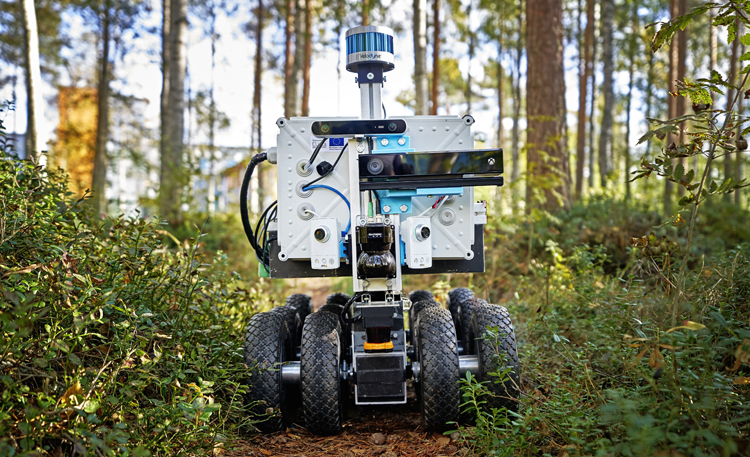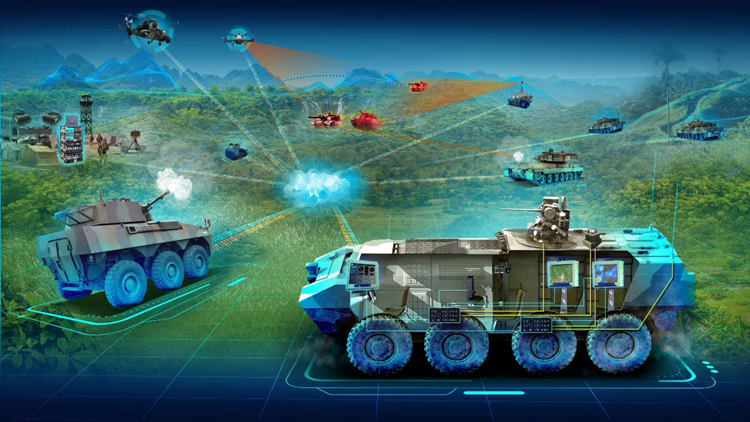INDIAN ARMED FORCES CHIEFS ON
OUR RELENTLESS AND FOCUSED PUBLISHING EFFORTS

SP Guide Publications puts forth a well compiled articulation of issues, pursuits and accomplishments of the Indian Army, over the years

I am confident that SP Guide Publications would continue to inform, inspire and influence.

My compliments to SP Guide Publications for informative and credible reportage on contemporary aerospace issues over the past six decades.
Disruption in Defence: Military robots breaking new ground on the battlefield
New developments in military robots are breaking the ground on the battlefield with new applications and tasks beyond the limit of human soldiers. Some of the latest projects include next-gen technologies, leading to military logistics and systems.

War can be extremely damaging both physically and mentally. In conflict today, most of the missions are directed in undefined battle conditions which turn extremely hazardous. Militaries are performing tasks that are physically demanding and paved with extreme danger. Military robots are now seen in a variety of roles beginning with military logistics and personnel and help improve operations.
The robots are unfolding in unlimited capacity in the autonomous role in the military with precision. Simply, beyond the machine advantage, a robotics soldier and equipment are many times more manned hours, and productivity on the battlefield.
The cutting-edge research on robotics and its application in the military at the University of Oulu and other Baltic countries especially in Estonia has led to some breakthroughs in military applications, combining artificial intelligence and robotics. The combination of AI & Robotics broke new ground based on the 5G/6G speed at the University of Oulu. The 6G could reach a theoretical peak data rate of 1 terabyte per second for wireless data, making new and innovative applications in wireless connectivity, cognition, sensing and imaging possible.
Importantly, in the military, the interactions between humans and robots are becoming increasingly apparent. With AI technology's help, this interaction is termed a conversational pattern.
Military robots are playing increasingly significant roles in various tasks, improving operations and productivity on the battlefield.
In the world of robotics, the most common types of military robots are transportation robots. The other key classifications are: Search and Rescue Robots, Surveillance and Reconnaissance Robots, Armed Robots and Training Robots, Mine Clearance Robots, and Firefighting Robots among others.
The area of robotics mainly involves developing theories, sensors, and platforms. This further enables mobile robots which are capable of performing military logistics missions and tasks on the battlefield alongside humans.
Within the EU framework, military robotic projects have been granted funded research from Finland and other EU countries which amount to more than $100 million. Robotics research activity at BISG includes collaboration with the processing industry.
The development has led to a wide variety of robots, including autonomous car platforms, mobile robots, drones, and cable drones. With the help of these robots, various military tasks have been achieved like autonomously convoying with AV, evacuating a dummy body, and many more.
The base of robotics and AI is the dedicated data-collecting unit that is used only for gathering and analysing data. Later it is integrated algorithms for tasks like autonomous operations, tracking, obstacle avoidance, etc.
Unmanned Ground Vehicles (UGVs) & LATACC programme
One of the key projects is the integrated Modular Unmanned Ground System (iMUGS) programme in the European Union (EU) which is especially led by the Baltic countries within the EU. The project is humongous in its scale and size and includes a dozen consortium members from across the EU. The project aims to achieve a standard architecture for unmanned ground vehicles (UGVs) for the militaries of the countries within the EU. The iMUGS programme is building a UGV capable of manned-unmanned and unmanned-unmanned teaming with other autonomous robotic platforms as well as manned main battle tanks.
This will be a breakthrough in military applications which could lead up to next-generation autonomous tanks, said a leading researcher working on the project.

Additionally, the UAV-UGV programme is also designed to extend into radiation measurement with UAV, ground mapping and 3D reconstruction in real-time. The concept will also involve low-cost UAV (about 100 EUR copter with external vision) swarms.
The origin of land-based robots dates back to 2006 when Probot, an EU entity began to work on the military concept. Its expertise is in modular robotics, easily customisable frames, distributed control nodes, real-world applications (logistics, gardening, farming, site survey, environment measurement), modular manufacturing (D3000 robot: PCB testing, 3D printing, small series manufacturing), embedded nodes for distributed control.
In the world of military robotics, some of the development also comes from the UK with their latest groundbreaking test for a 5-tonne UGV being successful in April. Other ongoing works are from Milrem's Type X and Rheinmetall's Wiesel from Germany.
Cutting-edge research in robotics and AI, particularly in the Baltic countries, is leading to breakthroughs in military applications, leveraging high-speed connectivity like 5G/6G.
Adding to this, the United States and Australia also leading in land-based autonomous military performing systems with an infusion of AI and drones, tanks and the Viking UGV.
Another key project which is termed as the most futuristic land-based military project is the Land Tactical Collaborative Combat (LATACC) project, coordinated by Thales.
The project is in collaboration with nine EU countries and is based on advanced cloud sensors, complex systems integration and robotics. The LATACC will integrate key elements of technologies and communication with AI. The whole programme is geared towards military application and system resilience in constrained battlefield situations.
The LATACC programme has brought 34 industry players and research institutes together to work on such a futuristic programme. Leading European countries and industries which include Thales, Rheinmetall, Leonardo, Indra, and Saab are jointly participating in this mega project. A total of 13 European countries are investing about €50 million in funding from the European Defence Fund.
According to a leading expert in the European Commission, the project objective is to complex and strategically important topic for the European defence community. The focus is to build advanced military platforms and equipment based on the collaborative capabilities of armed forces at various levels, from brigade command posts to combat vehicles, dismounted soldiers, and unmanned assets in high-intensity conflicts.
Additionally, the LARACC programme aims to boost existing systems, develop new technologies, and integrate them into a unified European framework.
Projects like the integrated Modular Unmanned Ground System (iMUGS) and Land Tactical Collaborative Combat (LATACC) aim to develop next-generation autonomous military platforms, integrating advanced technologies and collaboration among armed forces.
However, the biggest challenge comes from perception and localisation. Mostly, such land-based transport systems are generally integrated with light detection and ranging (LIDAR) sensors, which provide long-distance vision during the day and night to identify and avoid objects. As the reports suggest, the mechanism is based on the millions of data points which use laser beams, creating a live 3D map of its surroundings.
Again, the autonomy throws challenges a complex 'socio-technological' research area which requires further research in the development of robust and reliable sensing and data acquisition and integration of human-machine.
Further, the concept of hyper-personalisation algorithms which is under progress cananalyse data from a battlefield, such as the location of enemy combatants, the terrain, and the weather conditions, to determine the best course of action for a particular mission.
The cutting-edge research also includes the machine learning (ML) model. The model is based on two neural networks competingto make more accurate predictions. Examples include creating photorealistic photographs, voice cloning, facial animation, and image translation from one format to another. So, applying this technique in military warfare will let them know the best prediction through data evaluation and set a better strategy.
The author is a defence editor and security expert. He writes on National Security, Military Technology, Strategic Affairs & Policies.





